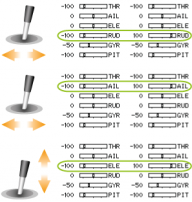Translations:Manuals:BXFbl:Radio Setup/7/en: Difference between revisions
Jump to navigation
Jump to search
Importing a new version from external source |
(No difference)
|
Latest revision as of 14:28, 9 April 2024
- Make sure that all trims and sub trims are disabled and that all servo travels are set to 100% in any flight mode. There mustn't be any active mixing functions (for example rudder revo-mixing). Have a look at the radio’s servo monitor: each stick has to control one channel / servo output (except for thrust stick which typically controls collective and motor at once when using a heli specific model memory). Please note when using a BEASTX flybarless device you won't directly control the servos of the helicopter. By moving a stick you pass a control command to the system which then performs the necessary servo movements. Each control command is bound to one servo output channel of the transmitter.
 |